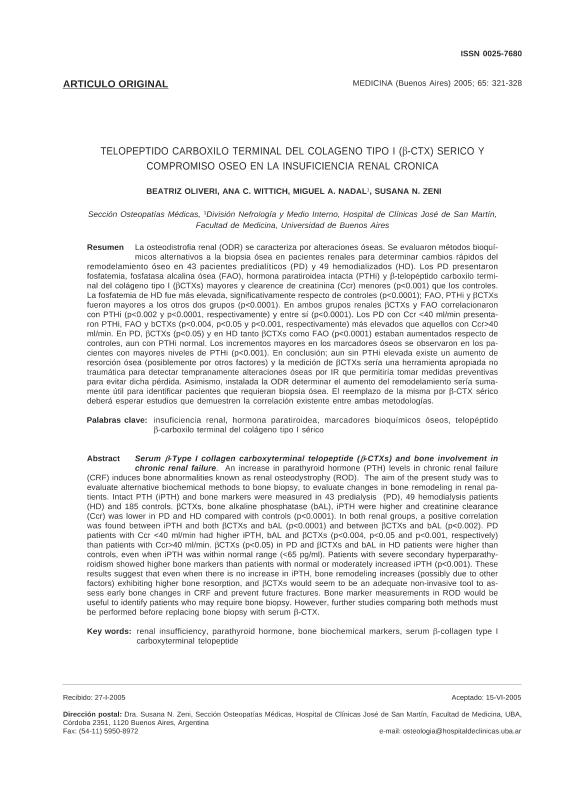Artículo
La osteodistrofia renal (ODR) se caracteriza por alteraciones óseas. Se evaluaron métodos bioquímicos alternativos a la biopsia ósea en pacientes renales para determinar cambios rápidos del remodelamiento óseo en 43 pacientes predialíticos (PD) y 49 hemodializados (HD). Los PD presentaron fosfatemia, fosfatasa alcalina ósea (FAO), hormona paratiroidea intacta (PTHi) y β-telopéptido carboxilo terminal del colágeno tipo I (βCTXs) mayores y clearence de creatinina (Ccr) menores (p<0.001) que los controles. La fosfatemia de HD fue más elevada, significativamente respecto de controles (p<0.0001); FAO, PTHi y βCTXs fueron mayores a los otros dos grupos (p<0.0001). En ambos grupos renales βCTXs y FAO correlacionaron con PTHi (p<0.002 y p<0.0001, respectivamente) y entre sí (p<0.0001). Los PD con Ccr <40 ml/min presentaron PTHi, FAO y bCTXs (p<0.004, p<0.05 y p<0.001, respectivamente) más elevados que aquellos con Ccr>40 ml/min. En PD, βCTXs (p<0.05) y en HD tanto βCTXs como FAO (p<0.0001) estaban aumentados respecto de controles, aun con PTHi normal. Los incrementos mayores en los marcadores óseos se observaron en los pacientes con mayores niveles de PTHi (p<0.001). En conclusión; aun sin PTHi elevada existe un aumento de resorción ósea (posiblemente por otros factores) y la medición de βCTXs sería una herramienta apropiada no traumática para detectar tempranamente alteraciones óseas por IR que permitiría tomar medidas preventivas para evitar dicha pérdida. Asimismo, instalada la ODR determinar el aumento del remodelamiento sería sumamente útil para identificar pacientes que requieran biopsia ósea. El reemplazo de la misma por β-CTX sérico deberá esperar estudios que demuestren la correlación existente entre ambas metodologías. An increase in parathyroid hormone (PTH) levels in chronic renal failure (CRF) induces bone abnormalities known as renal osteodystrophy (ROD). The aim of the present study was to evaluate alternative biochemical methods to bone biopsy, to evaluate changes in bone remodeling in renal patients. Intact PTH (iPTH) and bone markers were measured in 43 predialysis (PD), 49 hemodialysis patients (HD) and 185 controls. βCTXs, bone alkaline phosphatase (bAL), iPTH were higher and creatinine clearance (Ccr) was lower in PD and HD compared with controls (p<0.0001). In both renal groups, a positive correlation was found between iPTH and both βCTXs and bAL (p<0.0001) and between βCTXs and bAL (p<0.002). PD patients with Ccr <40 ml/min had higher iPTH, bAL and βCTXs (p<0.004, p<0.05 and p<0.001, respectively) than patients with Ccr>40 ml/min. βCTXs (p<0.05) in PD and βCTXs and bAL in HD patients were higher than controls, even when iPTH was within normal range (<65 pg/ml). Patients with severe secondary hyperparathyroidism showed higher bone markers than patients with normal or moderately increased iPTH (p<0.001). These results suggest that even when there is no increase in iPTH, bone remodeling increases (possibly due to other factors) exhibiting higher bone resorption, and βCTXs would seem to be an adequate non-invasive tool to assess early bone changes in CRF and prevent future fractures. Bone marker measurements in ROD would be useful to identify patients who may require bone biopsy. However, further studies comparing both methods must be performed before replacing bone biopsy with serum β-CTX.
Telopéptido carboxilo terminal del colágeno tipo I (beta-CTX) sérico y compromiso óseo en la insuficiencia renal crónica
Título:
Serum beta-type I collagen carboxyterminal telopeptide ( beta-CTXs) and bone involvement in chronic renal failure
Fecha de publicación:
12/2005
Editorial:
Medicina (Buenos Aires)
Revista:
Medicina (Buenos Aires)
ISSN:
0025-7680
e-ISSN:
1669-9106
Idioma:
Español
Tipo de recurso:
Artículo publicado
Clasificación temática:
Resumen
Archivos asociados
Licencia
Identificadores
Colecciones
Articulos(INIGEM)
Articulos de INSTITUTO DE INMUNOLOGIA, GENETICA Y METABOLISMO
Articulos de INSTITUTO DE INMUNOLOGIA, GENETICA Y METABOLISMO
Citación
Oliveri, María Beatriz; Wittich, Ana C.; Nadal, Miguel Angel; Zeni, Susana Noemi; Telopéptido carboxilo terminal del colágeno tipo I (beta-CTX) sérico y compromiso óseo en la insuficiencia renal crónica; Medicina (Buenos Aires); Medicina (Buenos Aires); 65; 12-2005; 321-328
Compartir




